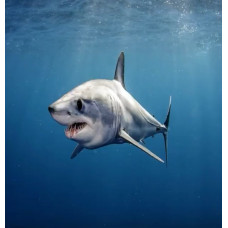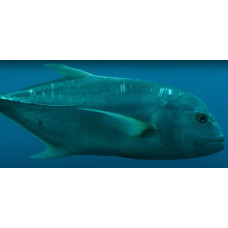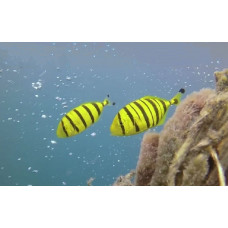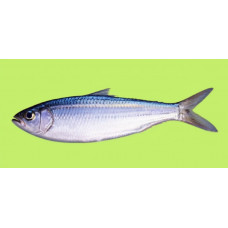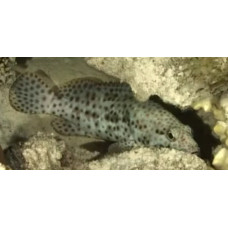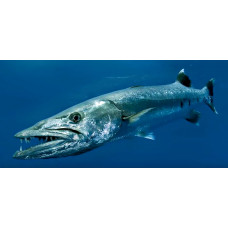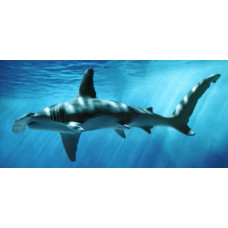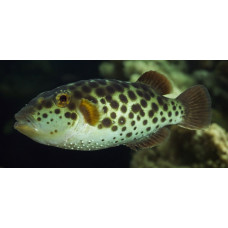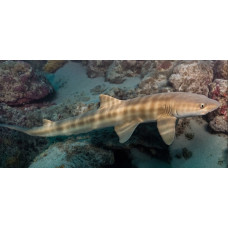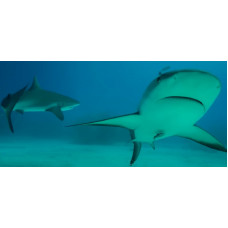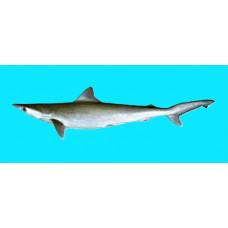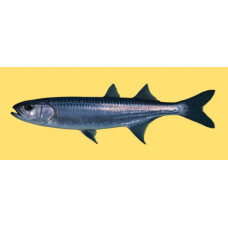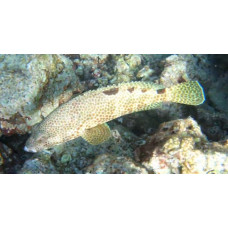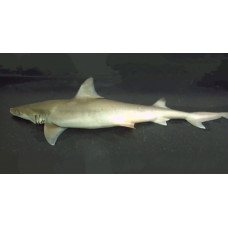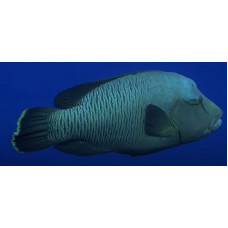Fauna of the Laccadive Sea
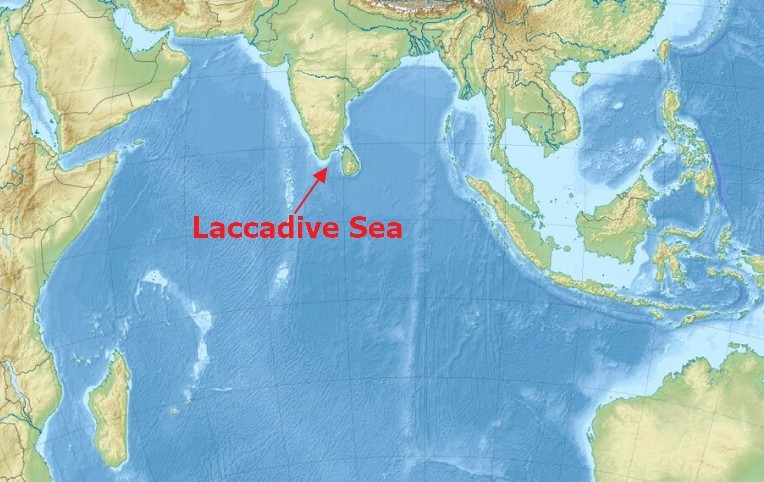 A marginal sea of the Indian Ocean, between the Laccadive Islands and the Maldives in the west and the coasts of the Indian Peninsula and Sri Lanka in the east. The western boundary runs from Addu Atoll (the southernmost of the Maldives) northwards along the western coasts of the Maldives and Laccadives before turning northeastwards to the mainland coast. The eastern boundary runs along the coast of the Indian Peninsula, the Strait of Polk, the western coast of Sri Lanka to its southwestern part (Cape Dondra), where it turns into Addu Atoll. Within these boundaries, the area of the sea is 786 thousand km2, its volume is 1516 thousand km3, the maximum depth is 4131 m (2°30′ N, 76°35′ E). Shallow shelf areas with depths up to 200 m occupy 13.6% and depths over 2 km - 56.5% of the bottom area. Bottom sediments consist of sands in the coastal parts and calcareous muds in the deepwater part. Coral reefs are widespread. The sea is located in the monsoon area of the equatorial belt, which determines the peculiarities of its climate. In winter there is a stable northeast monsoon with wind speeds of 5-7 m/s, in summer the same stable west monsoon, 5-7 m/s. The northern areas receive up to 3000 mm of rainfall per year, mostly in June-August; the southern areas receive about 2000 mm, with two peaks in April-May and October-November. The air temperature is about 28°C throughout the year, with maximum temperatures of 36°C and minimum temperatures of 20°C. The water temperature at the surface is 28-29°C, the salinity 33-35‰ in February and 34-35‰ in August. Tides are irregular and semi-diurnal, 0.9-1.6 m.
A marginal sea of the Indian Ocean, between the Laccadive Islands and the Maldives in the west and the coasts of the Indian Peninsula and Sri Lanka in the east. The western boundary runs from Addu Atoll (the southernmost of the Maldives) northwards along the western coasts of the Maldives and Laccadives before turning northeastwards to the mainland coast. The eastern boundary runs along the coast of the Indian Peninsula, the Strait of Polk, the western coast of Sri Lanka to its southwestern part (Cape Dondra), where it turns into Addu Atoll. Within these boundaries, the area of the sea is 786 thousand km2, its volume is 1516 thousand km3, the maximum depth is 4131 m (2°30′ N, 76°35′ E). Shallow shelf areas with depths up to 200 m occupy 13.6% and depths over 2 km - 56.5% of the bottom area. Bottom sediments consist of sands in the coastal parts and calcareous muds in the deepwater part. Coral reefs are widespread. The sea is located in the monsoon area of the equatorial belt, which determines the peculiarities of its climate. In winter there is a stable northeast monsoon with wind speeds of 5-7 m/s, in summer the same stable west monsoon, 5-7 m/s. The northern areas receive up to 3000 mm of rainfall per year, mostly in June-August; the southern areas receive about 2000 mm, with two peaks in April-May and October-November. The air temperature is about 28°C throughout the year, with maximum temperatures of 36°C and minimum temperatures of 20°C. The water temperature at the surface is 28-29°C, the salinity 33-35‰ in February and 34-35‰ in August. Tides are irregular and semi-diurnal, 0.9-1.6 m.
The inhabitants of the Laccadive Sea
There are numerous coral reefs in the sea, with the Lakkadive Islands, a group of atolls, having 105 species of coral. These reefs are home to a wide variety of marine life, including various species of fish, molluscs, starfish and anemones. The reefs are important biodiversity hotspots and support many unique and endemic species. The fish that live in сoral grouper, orange-spotted grouper, potato grouper, malabar grouper, greasy grouper, sea goldie, brownspotted grouper, yellow-edged lyretail, blacktip grouper, honeycomb grouper, network pipefish, black-barred halfbeak, ember parrotfish, dash-and-dot goatfish, hardyhead silverside, reef triggerfish, titan triggerfish, lagoon triggerfish, clown triggerfish, redtoothed triggerfish, orange-lined triggerfish, yellowmargin triggerfish, Indian triggerfish, bicolor blenny, white-spotted puffer, blackspotted puffer, green pufferfish. The archipelago is home to crevalle jack, crimson jobfish, mangrove red snapper, bigeye snapper, great barracuda, obtuse barracuda, pickhandle barracuda, humphead wrasse, bluestreak cleaner wrasse, moon wrasse, sling-jaw wrasse, queen coris, checkerboard wrasse, tripletail wrasse, black marlin, Indo-pacific blue marlin, striped marlin, round ribbontail ray, reticulate whipray, roughtail stingray, cowtail stingray, jenkins' whipray, broad stingray, whitespotted whipray, spotted eagle ray, spiny butterfly ray, reef manta ray, spinetail mobula, chilean devil ray, common eagle ray, sixgill stingray, deepwater stingray, ornate ghost pipefish. The lagoons and reef shoals are home to a variety of molluscs, including giant Maxima clams and octopuses. Gastropod molluscs include species such as the coney (Conus leopardus and C. litteratus) and cowrie (Cyprea caputserpentis and C. tigris).
Fishing in the Laccadive Sea
Fishing is one of the most important economic activities in the region. The sea is home to a variety of fish species including yellowfin tuna, skipjack tuna, albacore, wahoo, indian mackerel, indo-pacific king mackerel, narrow-barred spanish mackerel, frigate tuna, blue mackerel, striped bonito, mahi-mahi, pompano dolphinfish, round sardinella, goldstripe sardinella, indian anchovy, bronze featherback, giant trevally, pilot fish, golden trevally, bluefin trevally, bigeye trevally, yellowstripe scad, bigeye scad, longfin yellowtail, torpedo scad, yellowtail scad, indian threadfish, doublespotted queenfish, rainbow sardine, slender rainbow sardine and many other commercially valuable species. There is also a large prawn and lobster fishery. Coastal fisheries and aquaculture play an important role in sustaining the local economy.
Sharks in the Laccadive Sea
The Laccadive Sea is home to several species of sharks. The most common are the spadenose shark, milk shark, blacktip shark, Indian swellshark and the great hammerhead. The sea is also home to other species that are both dangerous and harmless to humans. These include tiger shark, oceanic whitetip shark, blue shark, blacktip reef shark, ganges shark, whitetip reef shark, grey reef shark, pondicherry shark, spot-tail shark, grey sharpnose shark, scalloped hammerhead, winghead shark, smooth hammerhead, whale shark, common thresher, pelagic thresher, bigeye thresher, shortfin mako shark, nurse shark, hooktooth shark, grey bamboo shark, arabian carpetshark.
Mammals of the Laccadive Sea
There are 24 species of cetaceans found in the Laccadive Sea. Some of these species are occasional visitors and others are permanent residents of the region. Giant blue whales can be found all year round in the equatorial waters. Humpback and fin whales live in coastal and shelf waters. Cuvier's beaked whale and sperm whale live in deeper waters. Killer whales swim both close to shore and in open waters. Common dolphin species in the area include: spinner dolphin, Indo-Pacific humpback dolphin, Indian Ocean humpback dolphin, common bottlenose dolphin and Risso's dolphin.
Ganges shark
Latin nameGlyphis gangeticusOther nameGlyphis gangeticusIdentificationThe Ganges shark is stocky, wi..
Giant trevally
Latin nameCaranx ignobilisOther namesLowly trevally, barrier trevally, ronin jack, giant kingfish, u..
Golden trevally
Latin nameGnathanodon speciosusOther nameGolden kingfish, banded trevally, king trevally.Identificat..
Goldstripe sardinella
Latin nameSardinella gibbosaOther nameGoldstripe sardineIdentificationThe body of the Goldstripe Sar..
Greasy grouper
Latin nameEpinephelus tauvinaOther nameArabian grouper or greasy rockcod.IdentificationThe body of t..
Great barracuda
Latin nameSphyraena barracudaOther namesSphyraena barracudaIdentificationCharacteristic of this fish..
Great hammerhead
Latin nameSphyrna mokarranOther namesSphyrna mokarranIdentificationThey have a characteristic spindl..
Green pufferfish
Latin nameDichotomyctere fluviatilisOther nameCeylon pufferfishIdentificationThe body of the green p..
Grey bamboo shark
Latin nameChiloscyllium griseumOther nameChiloscyllium griseumIdentificationThe grey bamboo shark ha..
Grey reef shark
Latin nameCarcharhinus amblyrhynchosOther namesGray reef sharkIdentificationThe body of the fish is ..
Grey sharpnose shark
Latin nameRhizoprionodon oligolinxOther nameRhizoprionodon oligolinxIdentificationThe grey sharpnose..
Hardyhead silverside
Latin nameAtherinomorus lacunosusOther nameBroad-banded hardyhead, broad-banded silverside, Capricor..
Honeycomb grouper
Latin nameEpinephelus merraOther nameBlack-spotted rock-cod, common birdwire rockcod, dwarf spotted ..
Hooktooth shark
Latin nameChaenogaleus macrostomaOther nameChaenogaleus macrostomaIdentificationThe hooktooth shark ..
Humphead wrasse
Latin nameCheilinus undulatusOther namesMāori wrasse, Napoleon wrasse, Napoleon fish.IdentificationA..

